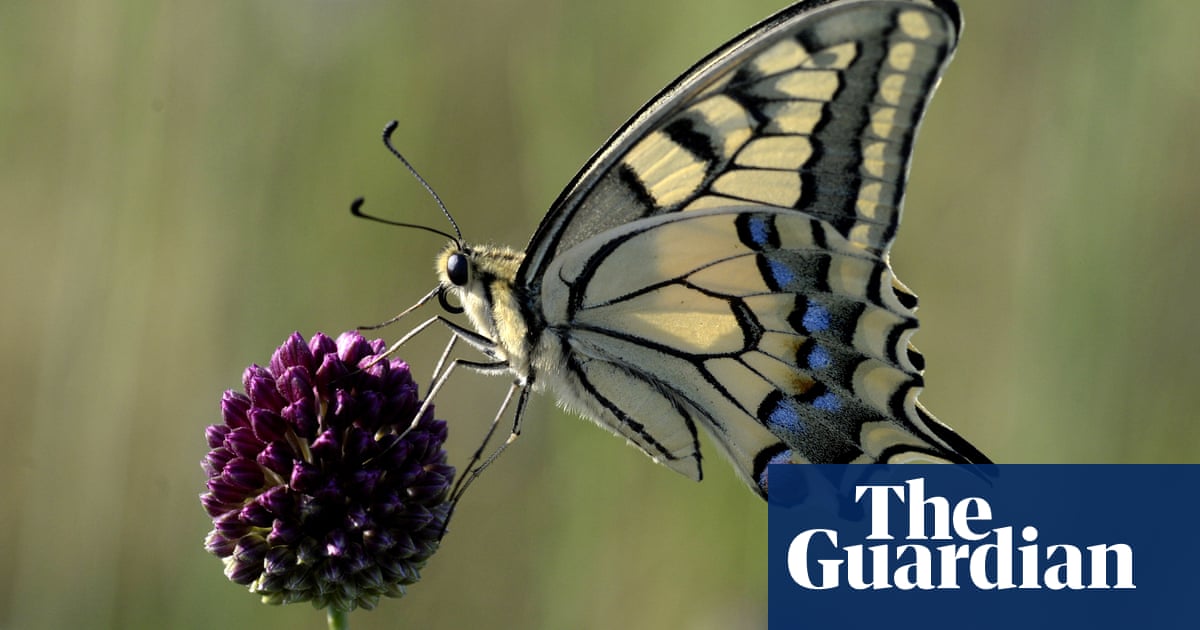
The swallowtail, one of Britain’s rarest butterflies and also the largest, has suffered its worst summer since records began.
The butterfly is confined to the Broads in East Anglia, where its caterpillar’s food plant is found, and is now breeding on just 16 sites.
The swallowtail is among hundreds of freshwater animals and plants in Britain’s smallest but most biodiverse national park which are imperilled by global heating.
Summer droughts and sea level rise are causing saltwater to enter the freshwater Broads, while winter floods are covering marshland with water for prolonged periods, threatening many rare species.
Conservation scientists fear that this summer’s swallowtail population could be even smaller because its chrysalises will have been submerged in flood water this winter for too long to survive.
The butterfly overwinters in its chrysalis, which is usually attached to reed stems close to the water. The chrysalis has been found to survive short periods underwater but many Broadland reed beds and marshes have been flooded since October.
Mark Collins, chair of the Swallowtail and Birdwing Butterfly Trust, said: “It’s very concerning. The swallowtail is a bellwether for what’s going on. There will be hundreds of species with similar tales of woe but we don’t know the detail.
“In the summer, saltwater is coming into the Broads because there is not enough freshwater falling as rain to keep it out. In winter, there is so much freshwater it can’t get away and so we’ve got flooding.”
Data collected for the UK Butterfly Monitoring Scheme shows just 81 swallowtails were counted during 2023, down from 138 the previous summer and 210 in 2020. Fewer individuals were recorded during the summers of 2012 and 2015 but the swallowtail has not been found breeding in so few places since scientific recording began nearly 50 years ago.
According to a University of East Anglia study, the Broads is home to more than 11,000 of Britain’s estimated 70,000 species, including more than 1,500 that are designated a priority for conservation. The majority of these depend on freshwater conditions.
One rare plant that needs freshwater to survive is milk parsley, the Broadland wild flower on which swallowtail caterpillars feed. Almost all the sites where milk parsley grows and swallowtails breed are at or below sea level.
The plant suffered from fungal wilt on one key nature reserve in 2021 which could have been exacerbated by the plant’s exposure to brackish water pushed upriver during storms. But to conservationists’ relief, there has been no sign of the fungal pathogen spreading across the Broads yet.
This year, the Royal Society for the Protection of Birds (RSPB) is seeking a licence from Natural England to propagate extra milk parsley and plant them in wet locations on slightly higher ground, which is less likely to be inundated by salt water or floods.
Ben Lewis, RSPB warden for Sutton Fen in Norfolk, which has a bigger swallowtail population than any other site, said 2022 was the driest year on record on the reserve and 2023 was the wettest. “It’s quite unbelievable. Unfortunately, with climatic changes this might be the boom and bust we have to get used to,” he said.
At Sutton Fen, milk parsley is responding well to cutting the fen in short rotations, and is prospering on specially cut “milk parsley pathways”. But he said the plant appeared to respond differently on different reserves.
Lewis added: “We’re collecting as much data as we can on locations and numbers of milk parsley plants and the health of the plants and referring back to the management practices in each area.
“Our key concern is ensuring we are managing our reserves with milk parsley in mind. But we can’t manage all the reserves for milk parsley or we’d lose other important fen flora.
“I’d like to see all the conservation bodies coming together to try to work it out.”
At Hickling national nature reserve, Norfolk Wildlife Trust has shifted flood banks back to create more species-rich wetlands in front of them but John Blackburn, the warden, said rising water levels in the Broads driven by the climate crisis were inundating new marshland up to 10 years ahead of forecasts.
“We’re always looking at ways of adaptation to find wetland habitat more wiggle room because it’s been hemmed in by flood banks,” said Blackburn.
“But my big concern this winter is how long the swallowtail chrysalises can cope with inundation.” Parts of Hickling have been under water since late October.
Many local residents suffering from prolonged flooding want higher flood banks and more dredging of rivers on the Broads but conservationists point out that increasing the dredging on rivers simply allows more saltwater to move upstream during high tides and storm surges.
According to Collins, winter flooding could be alleviated if estuaries and washes were recreated farther downstream, allowing large quantities of flood and tidal surge water to be naturally stored there.
Winter floods in the upper reaches of some parts of the Broads could be pumped along new channels and out to sea just a few miles away, he said.
He warned that saving the Broads will require a step change in funding. The Broads Authority, which manages the national park, now receives less than £4m in revenue funding each year from Defra, a real-terms cut of more than 40% since 2011.
Collins said: “We’re not recognising sufficiently the Broads national park’s ecosystem services to flood management, biodiversity conservation and carbon sequestration, not to mention wellbeing for its near 8 million annual visitors – it is a much underrated public benefit.
“If we’re going to protect the Broads as one of Britain’s most biodiverse and important nature areas, there should be pressure on Defra to greatly increase the funding for this magnificent wetland.”












